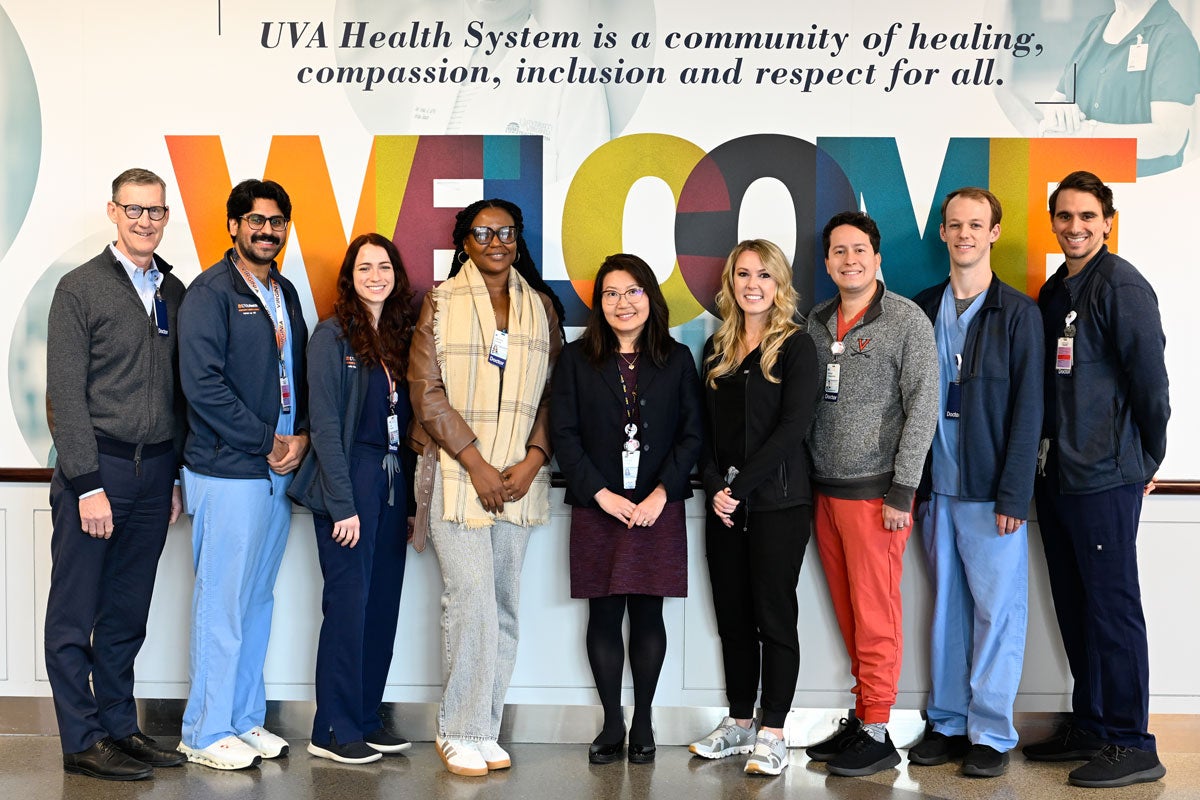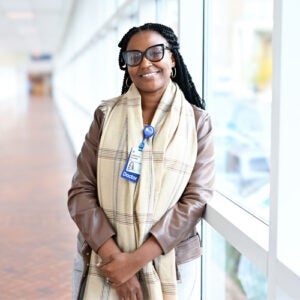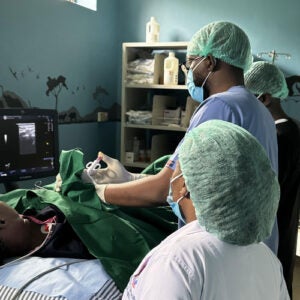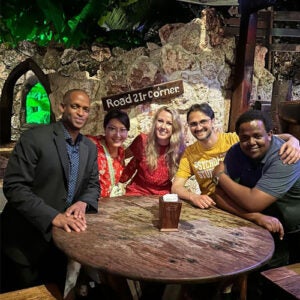
(from left) Department Chair Colin Derdeyn, MD; UVA Global Health Leadership Track residents Vatsal Lal, MD, and Julia Kariher, MD; visiting resident Catherine Kavishe, MD; GHLT Program Director Jenni Pierce, MD; UVA Global Health Leadership Track residents Olivia Richardson, MD, George Cheeseman, MD, Andrew Westberry, MD, and Connor Sleeth, MD.
The University of Virginia’s Department of Radiology and Medical Imaging held its annual Alumni and Friends Reception on December 3, 2024, in Chicago, IL. Across the room, more than 70 attendees saw the familiar faces of current and former trainees and faculty, who had been part of the UVA Radiology community for years, even decades. But that wasn’t the case for Catherine Kavishe, MD, a special guest at the reception. Dr. Kavishe, a final-year resident at the Muhimbili Orthopaedic Institute in Dar El Salaam, Tanzania, traveled more than 8,000 miles to Charlottesville, VA, to complete a visiting radiology rotation as part of a new initiative within UVA Radiology’s Global Health Leadership Track Program.
“This is a dream,” said Dr. Kavishe. “This year is ending really well.”

Catherine Kavishe, MD
The Power of a True Exchange Program
For the past decade, UVA Radiology’s Global Health Leadership Track (GHLT) and the Spencer B. Gay Resident International Education Fund have given UVA Radiology residents the opportunity to visit Uganda and Tanzania. Over a dozen UVA residents have traveled to these medical institutions in order to expand their medical knowledge and maintain an international educational exchange.
But Dr. Kavishe’s visit to Charlottesville marks the beginning of the GLHT becoming a “true” exchange program. She’s the first international resident to come to UVA as part of the program; and as the GHLT celebrates its 10th anniversary, the department aims to regularly host radiology residents from developing countries at UVA.
Within radiology, Dr. Kavishe has a particular interest in Musculoskeletal Imaging and Interventions (MSK). But while she’s trained in general radiology, there are limited opportunities to specialize in MSK within Tanzania. At UVA, she trained with several MSK radiologists including Jennifer Pierce, MD, the director of the Global Health Leadership Track and the division chief of MSK. It was a productive experience.

An IR procedure at Muhimbili National Hospital.
“[I saw] a ton of procedures that I wanted to see,” said Dr. Kavishe. “A lot of arthrograms, a lot of joint injections – something that back home, the orthopedic surgeons really want. So, I think it has been a very successful process.”
After her training at UVA, Dr. Kavishe sees the opportunity to create meaningful change at her home institution.
“We have everything there: We have fluoroscopies, we just lack the skills and the exposure,” she said. “And I think with a little help, we can have our MSK fellowship there.” And maybe, she said, “I can be the first MSK fellow.”
Connecting Through Interventional Radiology
In April 2024, Olivia Richardson, MD, traveled more than 8,000 miles east to eventually arrive at Muhimbili National Hospital in Dar El Salaam, Tanzania (about 15 meters away from Muhimbili Orthopaedic Center). As a second-year resident within UVA Radiology’s Global Health Leadership Track, Dr. Richardson immediately felt supported.

Olivia Richardson, MD, traveled to Tanzania as part of UVA Radiology’s Global Health Leadership Track.
“The collaboration was something that felt very similar to UVA,” said Dr. Richardson. “Waking up, knowing that people on your team were motivated to help people: [even] that they knew nothing about, from another country.”
Her visit signaled another important first for the Global Health Leadership Track. Dr. Richardson is an Interventional Radiology (IR) resident, specializing in minimally invasive, image-guided procedures. Her trip was UVA’s inaugural collaboration with Road2IR, an outreach and education program with a mission to bring IR to underserved African areas.
“UVA is one of the few institutions who have made it possible for IR to participate in a Global Health Leadership Track,” said Dr. Richardson. “I think this is a unique aspect of our training program: to provide residents with the tools and leadership skills needed to identify and solve complex problems, promote unity in culturally diverse settings, and ultimately drive global transformation in IR.”
The trip offered valuable insights for Dr. Richardson. Muhimbili National Hospital is an ocean away from UVA Hospital; it also contains approximately 1,500 beds, compared to UVA Hospital’s 659. There were also differences in medical resources, with regards to operational expenses and limited tools.
“I don’t think this was a negative,” said Dr. Richardson. “It gave me an appreciation for what can be done with less.”

Dr. Richardson’s trip was made possible through UVA’s collaboration with the organization Road2IR.
However, her biggest takeaway doesn’t have to do with differences, but rather similarities.
“Hearing the stories from the different trainees of what drove them to IR was not very different from myself: the love for innovation, problem solving, and helping patients when other hope is not possible,” said Dr. Richardson. “Finding that kind of motivation is what sustains me, and so it was very inspirational to see so many other people share in that same desire from across the world.”
For Richardson, this sort of common ground is what allows hospitals to thrive, whether in in Dar El Salaam or Charlottesville. “I’m a firm believer that the most important aspect of any successful operation is having a great culture,” said Dr. Richardson.
You can donate to the Spencer B. Gay Resident Education Fund, which supports the Global Health Leadership Track, here.
Filed Under: Education
